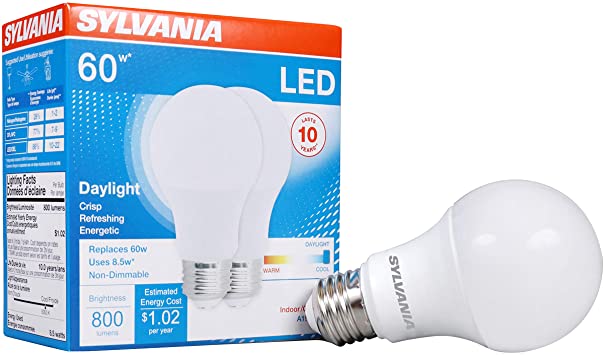
For a limited time, one major local home improvement retailer in the United States is offering a non-dimming 60 W equivalent LED A19 type bulb for $2.49 each, sold in a two bulb value pack manufactured by a major LED maker. Similar types of bulbs were about 6x the cost a few years ago. With price drops like this, we tend to see articles and discussions about the fall in LED bulb prices over the past few years, performance comparisons to previous versions on lumens/watt trends, or teardowns and investigations into the cost of materials etc. I decided to do a teardown to look at the design changes that went into this bulb to drive down cost versus an LED bulb from just a few years ago. The trends to note from this perspective have been ongoing, but then the question to ask ourselves as designers is where will the basic design of an LED bulb step to next?
Figure 1 is a picture of the $2.49 bulb and as you can tell I was not trying to be pretty about the heat sink and casing as I was more interested in the driver at first. It requires 8.5 W for a 60 W equivalent at 800 Lumens A19 bulb.
Figure 1. $2.49 A19 60 W Equivalent LED Bulb
Figure 2. Older A19 60 W Equivalent LED Bulb for comparison
Figure 2 shows the teardown from a bulb taken apart a few years ago, it cost $15.99 but I promised not to get into a LED pricing reduction analysis. By the way, it required 8 W for only a 40 W equivalent at 450 Lumens A19 bulb.
To begin with, removing the plastic “optics” used to require a heat gun, but now days most of the time you can pry the plastic cover from the heat sink base. Then simply remove a few screws and release the driver inside the casing. In older bulbs, there was still potting material inside the casing surrounding the driver along with a series of interlocks holding the casing to the heat sink. Potting material is still used today, but I am considering general trends in the construction of LED bulbs. The new bulb weighs around 49 g total, the old bulb heat sink alone is 70 g so for the same input power to the bulb, the heat sink is smaller and there is no potting around the driver. The number of LEDs went from 18 to 11 with the lumen output almost double. I did not measure the LED voltage on the old string, but I measured over the 60 V SELV limit on the new bulb as safety is now achieved from the mechanical housing not through electrical isolation from the driver. Therefore, it’s obvious that lower weight, less LED counts, better materials or materials that function good enough can all contribute to lower cost.
The driver is more interesting. The old driver was an isolated flyback design. The controller has power factor correction, but what is not shown in Figure 2 is the added expense of having to cut the printed circuit board along the primary to secondary isolation boundary for safety creepage and clearance. The new driver is non-isolated and does not use a controller, but a set of discrete components. The new driver has a smaller EMI filter and even the transformer is smaller. The BOM count was 53 or so in the past versus 27 or so today – this will reduce cost and improve reliability in the driver. [1]
Clearly, the trend is to reduce the driver electronics besides the material changes and efficiency of LEDs. So where are drivers for LED bulbs going next? Integration: but there are discrete designs that use the low cost components without the need for an integrated analog controller that provides good enough performance. NPN transistors in place of MOSFET transistors, better EMI filtering, fuses part of the printed circuit board, etc. Non-isolated designs: when thinking about this trend and reducing component count the idea of Direct AC LED topologies can reduce the component count further and possibly eliminate some of the lower reliability electrolytic capacitors.
But how do these observations enable a smart LED solution? Lighting is evolving from something used to see or read, but is becoming a user experience: warm dimming, color tuning, communication to control, visible light communication to guide us, sensors that interpret implicit human movement or environment changes, etc. The latest low cost LED Bulb is a pathway to enable the technologies to take lighting into the future by reducing not just cost, but by pushing the boundaries on how we think about the construction of the bulb and how we challenge conventional thinking about consumer electronic design. As a semiconductor supplier, the need is to stay ahead of the curve by providing the building blocks to make these future lighting applications realized, how many suppliers are there that can provide these building blocks? I know of one that is developing the building blocks to advance lighting into the smart future. [2]
